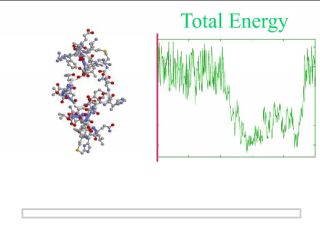|
Computational Biophysical Chemistry
|
Hansmann Group
|
|
|
|
Dept. of Chemistry and Biochemistry
University of Oklahoma
101 Stephenson Parkway
Norman, OK 73019-5251,USA
E-mail: uhansmann at ou.edu
Twitter: @HansmannLab
Research in our group focuses on the physics of proteins, "nanomachines" that are responsible for transporting molecules, catalyzing and regulating biochemical reactions in the cell, or as antibodies for fighting infections. As proteins are only functional if they assume specific shapes, it is important to explore how these structures emerge from a protein's chemical composition (the sequence of amino acids as specified in the genome) and its interaction with other molcules. Such knowledge could not only lead to the rational design of novel drugs, but also to a deeper understanding of various diseases that are caused by misfolding of proteins.
 Computer simulations offer one way to explore this sequence-structure
relation but are extremely difficult for realistic protein models.
A significant
part of the research in our group aims at overcoming this obstacle through the
development of novel numerical techniques. Some of these algorithms are
implemented in our free software package SMMP.
Computer simulations offer one way to explore this sequence-structure
relation but are extremely difficult for realistic protein models.
A significant
part of the research in our group aims at overcoming this obstacle through the
development of novel numerical techniques. Some of these algorithms are
implemented in our free software package SMMP.
In our lab, we use these techniques to probe for small proteins the mechanism of folding and fold switching. We are especially interested in the conditions under which proteins mis-fold and aggregate. Here, we focus on the question whether and how microbial infections can hasten and/or alter generation and growth of amyloid fibrils, whose presence is often related to the outbreak of neurological diseases. Protein-ligand binding and protein interaction with membranes belong to the same research direction and provide an interface for collaborations with experimental groups.
 CBSB2018: 20-23 May 2018
CBSB2018: 20-23 May 2018